#Cretaceous Morocco fossil
Explore tagged Tumblr posts
Photo

7" Genuine Spinosaurus Dinosaur Tooth Fossil, Kem Kem Beds, Cretaceous Morocco | Massive Authentic Specimen + COA
7" Genuine Spinosaurus Dinosaur Tooth Fossil – Kem Kem Beds, Tegana Formation, Aptian Stage, Cretaceous: Kem Kem Basin, Morocco
A truly colossal fossil specimen — this 7-inch Spinosaurus tooth is a rare and highly desirable piece from one of the largest known theropod dinosaurs. It originates from the world-renowned Kem Kem Beds in the Tegana Formation, within the Kem Kem Basin of southeastern Morocco. This fossil dates back to the Aptian stage of the Early Cretaceous, approximately 113 to 100 million years ago.
Fossil Type & Species:
Type: Vertebrate Fossil (Tooth – Crown Specimen)
Species: Spinosaurus aegyptiacus
Order: Theropoda
Superfamily: Megalosauroidea
Family: Spinosauridae
First Described By: Ernst Stromer, German palaeontologist, 1915
Geological Details:
Formation: Tegana Formation
Beds: Kem Kem Beds
Geological Stage: Aptian (Early Cretaceous)
Biozone: Kem Kem Compound Assemblage Zone
Depositional Environment: Dynamic fluvial and deltaic ecosystem composed of ancient rivers, floodplains, and lakebeds. This region preserved a rich diversity of both aquatic and terrestrial prehistoric life in iron-rich sedimentary deposits.
Morphology & Features: This magnificent tooth features all the distinctive traits of a Spinosaurus specimen:
Elongated conical shape — adapted for grasping slippery aquatic prey
Non-serrated edges — unlike most other theropod dinosaurs
Vertical enamel ridges along the shaft
Fossilised colour tones of deep red, brown, ochre, and sand hues
Excellent crown preservation with tapering natural tip and broken base at the root
Notable: Spinosaurus aegyptiacus is believed to be the largest theropod dinosaur ever discovered — potentially surpassing even Tyrannosaurus rex in length. With a crocodilian skull, tall neural spines forming a sail, and adaptations for a semi-aquatic lifestyle, it remains one of the most fascinating dinosaurs known to science.
Teeth of this impressive size (7 inches) are exceptionally rare and highly collectible. Most specimens this large are found only in museum collections.
Specimen Details:
Origin: Kem Kem Basin, near Taouz, Morocco
Formation: Tegana Formation, Kem Kem Beds
Species: Spinosaurus aegyptiacus
Fossil Type: Isolated Tooth (Crown)
Length: Approx. 7 inches
Size Reference: Scale rule square = 1cm (please see photo for full sizing)
Note: The actual fossil shown in the photo is the one you will receive
Authenticity & Quality: All fossils are 100% genuine and are selected for their scientific and aesthetic value. This tooth comes with a Certificate of Authenticity and has not been restored, reconstructed, or artificially enhanced.
Why Choose This Fossil? This 7-inch Spinosaurus tooth is a museum-grade fossil and an outstanding addition to:
Professional or private collections
Educational institutions and natural history displays
Dinosaur fossil investors and enthusiasts
Shipping & Packaging: Carefully packaged using eco-conscious materials. Fast and secure shipping with expert handling to ensure safe delivery of your fossil.
Own a remarkable relic from the largest carnivorous dinosaur to ever walk the Earth — this massive Spinosaurus aegyptiacus fossil tooth.
All of our Fossils are 100% Genuine Specimens & come with a Certificate of Authenticity.
#Spinosaurus tooth fossil#7 inch dinosaur tooth#extra large dinosaur fossil#genuine Spinosaurus aegyptiacus tooth#Kem Kem Beds fossil#Cretaceous Morocco fossil#Aptian dinosaur tooth#Tegana Formation fossil#rare dinosaur fossil#authentic fossil tooth#real dinosaur tooth#fossil with COA#large theropod tooth#carnivorous dinosaur fossil#collector fossil specimen
0 notes
Text
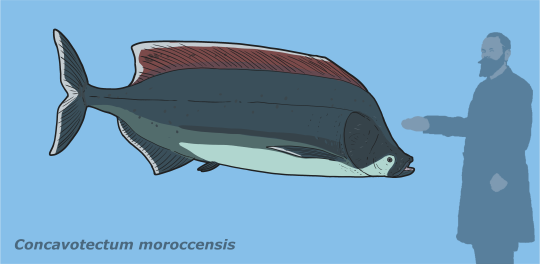
Spinosaurus drama is cool and things, but do you know what's even cooler? Better fossils of animals that lived with Spinosaurus!
There is a new specimen of Concavotectum currently on display in Tuscon. BigSkyFossils took some photos of it and I had to doodle it! It's been a while since I did a tselfatiform and now we have finally an idea how the postcranium looked like!
So far we only had a few fragments and this pretty good skull. As some people noted though, the eye is reconstructed in the wrong corner.

#sciart#paleoart#paleostream#palaeoblr#cretaceous#spinosaurus#kem kem#morocco#fossil fish#concavotectum
4K notes
·
View notes
Text

The distinctive pinhole eyes, leathery hood, and numerous tentacles of modern nautiluses were traditionally thought to represent the "primitive" ancestral state of early shelled cephalopods – but genetic studies have found that that nautiluses actually secondarily lost the genes for building lensed eyes, and their embryological development shows the initial formation of ten arm buds (similar to those of coeloids) with their hood appearing to be created via fusing some of the many tentacles that form later.
There's a Cretaceous nautilidan fossil that preserves soft tissue impressions of what appear to be pinhole eyes and possibly a remnant of a hood, so we know these modern-style nautilus features were well-established by the late Mesozoic. But for much more ancient Paleozoic members of the lineage… we can potentially get more speculative.
So, here's an example reconstructed with un-nautilus-like soft parts.
Solenochilus springeri was a nautilidan that lived during the Late Carboniferous, around 320 million years ago, in shallow tropical marine waters covering what is now Arkansas, USA.
Up to about 20cm in diameter, (~8"), its shell featured long sideways spines which may have served as a defense against predators – or possibly as a display feature since they only developed upon reaching maturity.
———
NixIllustration.com | Tumblr | Patreon
References:
Anthony, Franz. "500 million years of cephalopod fossils" Earth Archives, 19 Feb. 2018, https://eartharchives.org/articles/500-million-years-of-cephalopod-fossils/index.html
Klug, Christian, et al. "Preservation of nautilid soft parts inside and outside the conch interpreted as central nervous system, eyes, and renal concrements from the Lebanese Cenomanian." Swiss Journal of Palaeontology 140 (2021): 1-11. https://doi.org/10.1186/s13358-021-00229-9
Korn, Dieter, and Christian Klug. "Early Carboniferous coiled nautiloids from the Anti-Atlas (Morocco)." European Journal of Taxonomy 885 (2023): 156-194. https://doi.org/10.5852/ejt.2023.885.2199
Kröger, Björn, Jakob Vinther, and Dirk Fuchs. "Cephalopod origin and evolution: a congruent picture emerging from fossils, development and molecules: extant cephalopods are younger than previously realised and were under major selection to become agile, shell‐less predators." BioEssays 33.8 (2011): 602-613. https://doi.org/10.1002/bies.201100001
Mikesh, David L., and Brian F. Glenister. "Solenochilus Springeri (White & St. John, 1868) from the Pennsylvanian of Southern Iowa." Proceedings of the Iowa Academy of Science. Vol. 73. No. 1. 1966. https://scholarworks.uni.edu/pias/vol73/iss1/39/
Shchedukhin, A. Yu. "New Species of the Genus Acanthonautilus (Solenochilidae, Nautilida) from the Early Permian Shakhtau Reef (Cis-Urals)." Paleontological Journal 58.5 (2024): 506-515. https://www.researchgate.net/publication/384922837_New_Species_of_the_Genus_Acanthonautilus_Solenochilidae_Nautilida_from_the_Early_Permian_Shakhtau_Reef_Cis-Urals
Wikipedia contributors. “Nautilida” Wikipedia, 26 Nov. 2024, https://en.wikipedia.org/wiki/Nautilida
Wikipedia contributors. “Solenochilus” Wikipedia, 28 Apr. 2022, https://en.wikipedia.org/wiki/Solenochilus
#science illustration#paleontology#paleoart#palaeoblr#solenochilus#solenochilidae#nautilida#nautiloid#cephalopod#mollusc#invertebrate#art#doing the inverse of all those ammonite reconstructions that make them look like nautiluses
220 notes
·
View notes
Text
Croc Paleontology Recap January 2025
The year has just begun and already we got a bunch of pretty neat new studies on fossil pseudosuchians so I'll just briefly go over them and unless I forget or end up procrastinating/getting too busy I'll hopefully be able to keep this going throughout the rest of the year.
Just to give you a brief overview, the highlights of this month include: salt glands in gavialoids, crocodilian predation on azhdarchids, diversifications and extinctions in thalattosuchians and a new species of aetoaur from India. Lets begin.
Evidence for salt glands in gavialoids
Starting off with something relating to the dispersal of gavialoids, we got "Evaluation of the endocranial anatomy of the early Paleogene north African gavialoid crocodylian Argochampsa krebsi and evolutionary implications for adaptation to salinity tolerance in marine crocodyliforms" by Pliggersdorfer, Burke and Mannion.
The title already gives a lot away, but the point was that Argochampsa, from the early Paleocene Ouled Abdoun Basin in Morocco, was examined for evidence of salt tolerance. Why? Because the dispersal of gavialoids remains weird. Both modern forms aren't especially keen on saltwater and are only known to consistently occur in freshwater (tho we have a recent example of an indian gharial caught in a fishing net off the coast of India), yet we have plenty of extinct gavialoids that either indicate that the group must have crossed oceans (see any "gryposuchine") or straight up lived at sea (also see some "gryposuchines").
Now, one such example might also be Argochampsa. Both because the Ouled Abdoul Basin famously preserves coastal deposits and because, at least following some phylogenies, Argochampsa might be closely related to the gharials of South America and today (others say its not even a gavialoid but lets ignore that for now). So all things considered one might expect marine habits from Argochampsa, yet so far no such adaptations could be identified. Well, Pliggersdorfer and co. analyzed a thus-far undescribed skull and actually managed to find something. Small depressions on the inside of the skull are suspiciously similar to ones seen in the extinct, fully marine metriorhynchoids, depressions that in the latter have been interpreted as having been left by salt glands. There is also some further evidence through the morphology of the inner ear.
This conclusion further extends to a handfull of other taxa, including the dyrosaurid Rhabdognathus and the recently named gavialoid Sutekhsuchus, and lends itself to the hypothesis that salt glands may have been ancestral to gavialoids, something I personally find unsurprising given their proximity to crocodyloids and their dispersal across the world (really if anything alligatoroids seem like the odd one out).
Fun fact, yours truly is featured in the paper in the form of two silhouettes.
Left: Argochampsa, illustrated by Seismic Shrimp/JW Right: Piscogavialis, perhaps the most famous marine gavialoid, illustrated by Joschua Knüppe


The brain of Paralligator
Second on our neat little list, the neuroanatomy of Paralligator, studied through CT scans and 3D modeling and published on in "Neurocranial anatomy of Paralligator (Neosuchia: Paralligatoridae) from the Upper Cretaceous of Mongolia". Given that I am not great with brain things, I'll keep this one short.
Now for those unfamiliar, Paralligator is part of a somewhat strange clade known as the Paralligatoridae, which contrary to their name are nowhere near real alligators (tho some do look deceptively similar). Instead, they are much more basal members of Eusuchia.
Measurements of the olfactory bulbs, responsible for the sense of smell, indicate that in Paralligator this sense was similarily developed to allodaposuchids and crocodilians, as is the inner ear who's anatomy suggests a semi-aquatic lifestyle. Paralligator does however differ in possessing a mesothemoid, a bony septum in the olfactory region that is also seen in dyrosaurids, baurusuchids and dinosaurs, but not modern crocodiles.

Borealosuchus remains from Colorado
Tho seemingly unexciting, this study, "First record of Borealosuchus sternbergii from thelower Paleocene Denver Formation (lower Danian),Colorado (Denver Basin)" actually helps us fill a neat little gap in our previous knowledge on croc survival across the Cretaceous-Paleocene extinction.
Simply put, though America's croc record across the KPG is rather remarkable, showing both many survivors and some incredible diversification after the impact, Colorado is kind of a blind spot, despite its potential importance. Perhaps one of the best examples of a survivor concerns the genus Borealosuchus, which is both geographically and stratigraphically widespread. To put things into perspective, this genus occured as far north as Canada and as far south as Texas, first appearing in the Late Cretaceous and dying out in the Eocene.
This paper now described several skulls from the Corall Bluff's locality of the Denver Formation, earliest Paleocene, that can be attributed to Borealosuchus sternbergii, definitively extending its range beyond KPG (granted, there are tentatively referred Paleocene occurences elsewhere), making it one of the largest suvivors of the mass extinction, with adults growing up to 2.3 meter in length. The specimens from Colorado are smaller, in the 1.5 to 1.7 meter range, but they are also regarded as immature individuals and are therefore also regarded as usefull in illustrating how the animals changed as they grew into adulthood.
This paper is especially well timed for those that follow @knuppitalism-with-ue 's Formation Stream series. As you might know, Corall Bluffs is to be drawn barely a week from now and this is a fantastic addition.
Left: Borealosuchus drawn by Atak_Draws Right: Distribution of Borealosuchus by Lessner, Petermann and Lyson 2025

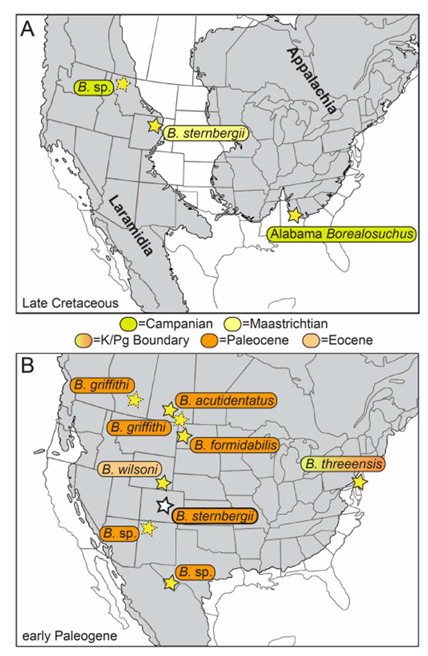
Growth of a peirosaur
Our next paper for discussion is "Life history and growth dynamics of a peirosaurid crocodylomorph (Mesoeucrocodylia; Notosuchia) from the Late Cretaceous of Argentina inferred from its bone histology" by Tamara G. Navarro and colleagues. This study conducted the first histology of peirosaurid limb bones, specifically of an indetermined taxon clading together with Uberabasuchus.
As a brief refresher, peirosaurids are a branch of medium to large sized Notosuchians that I personally think can be aptly described as appearing somewhat like scaly dogs or pigs with often robust, wedge-shaped heads and heavily armored bodies.
The results show that the animal had reached sexual maturity, yet was not yet fully grown. What's also noted is the exact growth dynamics of this animal. This is to say, the studied peirosaurid had overall slow growth with cycles of no growth whatsoever and two periods of increased growth, tho once put against other notosuchians the study deems the growth rates to be better described as "moderate". Pepesuchus meanwhile, belonging to the closely related itasuchids, was a fast grower. Extending things beyond their shared clade shows a virtual mish-mash of dynamics, with Araripesuchus buitreraensis displaying slow growth rates (yet Araripesuchus wegeneri having faster rates than the peirosaur), Iberosuchus showing slow rates, and Notosuchus displaying high growth rates (hell, theres even variation between individuals). A final point concerns the age of the individual, which is....contradictory. Based on the limb bones, the study estimates that the animal was at the very least 15 years old, but previous study of the osteoderms has yielded an estimated age of 18 years old. Ultimately, further study is needed, but it does clearly show how the histology of different parts of the skeleton varies.
Shown below, Uberabasuchus terrificus by Scott Reid

Predation on pterosaurs
Here's a fun one, "A juvenile pterosaur vertebra with putative crocodilian bite from the Campanian of Alberta, Canada", once again with a name that tells you very much what you're in for.
Brown and colleagues report on the discovery of a juvenile specimen of the azhdarchid Cryodrakon from the Dinosaur Park Formation of Alberta, Canada. The neck vertebra bears some conical bite marks, notably different from those of theropods, which generally have D-shaped or compressed tooth crosssections (sans spinosaurids, which aren't present). Champsosaurus is also ruled out due to its inferred feeding preferences, weak bite force and slender teeth. Mammals are potential candidates, but the team regards it as more likely that the trace maker was a crocodilian. Considering the fauna of the Dinosaur Park Formation, this would suggest the culprit was either Leidyosuchus, Albertochampsa or an animal described as "Stangerochampsa-like".
Now this is a very interesting, if not exactly unexpected interaction. On the one hand, having direct fossil evidence for this is a big deal, even if we don't know if the bite marks were left due to the pterosaur being actively hunted or if they were simply left when a lucky croc came across the carcass of an already deceased Cryodrakon. On the other hand, crocodiles and kin are notoriously opportunistic and broad in their diet, so one feeding on a pterosaur is something that seems like a no-brainer in principle, especially a relatively small individual with a wingspan of "only" 2 meters. This is further supported by the fact that crocodilian bite marks have also been reported from the Romanian pterosaur Eurazhdarcho.
Obvious difference in prey size and geography aside (and taxon names even within the chosen setting while we're on it), Prehistoric Planet really nailed the nailon the head with this one.
In the left corner, a juvenile Cryodrakton (art by Hank Sharpe). In the right corner, Leidyosuchus (art by Gunnar Bivens) LET THEM FIGHT (or scavenge)


Evolutionary trends and extinctions in Thalattosuchia
This one's a last minute entry, by which I mean this one got just published as I was about to wrap this whole thing up. "Analysing Thalattosuchia palaeobiodiversity through the prism of phylogenetic comparative methods" explores how the evolution and the extinctions of members of this group were shaped by both biotic and abiotic factors.
Given the shere breadth of this topic, a quick summary of thalattosuchia seems kinda in order. In short, thalattosuchians are a group of what are likely to be early crocodyliforms adapted to life at sea. They can be split into two groups, the teleosauroids, superficially gharial like animals that likely stuck to coastal waters, and the metriorhynchoids, open ocean animals with fluked tails, no body armor and paddle-like limbs. Both groups reached their greatest diversity in the late Jurassic, but managed to survive into the Cretaceous before disappearing entirely.
The study recaps that thalattosuchians first reach great diversity during the Toarcian, tho this is likely influenced by preservation bias thanks to Lagerstätten such as the Posidonia shale, and a later diversification takes place during the Bathonian. Regardless, the transition from the lower to middle Jurassic sees an increased trend in both thalattosuchian groups towards shorter snouts, which are associated with durophagy or hypercarnivory. This essentially gives rise to the teleosauroids of the Machimosaurinaei, which appear during the Bathonian and have blunt, robust teeth, as well as the metriorhynchoid Geosaurinae, which appeared at the same time and had ziphodont (serrated teeth). The reasons for this could be twofold. On the one hand, thalattosuchians were very abundant, so expanding into new nisches helped them coexist, with ecosystems preserving fish-eaters, hypercarnivores, durophages and more at the same time. More of an underlying factor could be a drop in ichthyosaur diversity, leaving plenty of open nisches for these crocs to fill.
Subsequently, during the transition from the Middle to Late Jurassic, there was another diversification event with both groups establishing new major clades, possibly associated with the warm temperatures of the Late Jurassic, before the diversity crashes with the onset of the Cretaceous. The authors note that this too might have been related to climate, with the Cretaceous survivors mostly being found in warmer waters.
Left: A Dakosaurus ambushing an ichthyosaur by Gabriel Ugueto Right: A large Machimosaurus rests on the beach as a sauropod approaches, art by Joschua Knüppe


and for the final study I wanna talk about
Kuttysuchus: A new Aetosaur from India
Now, by all accounts one might be surprised to see this just kinda thrown in at the end here rather than getting a dedicated post as I usually like to do with new forms. And truth be told, theres just not that much to say about "A New paratypothoracin aetosaur (Archosauria: Pseudosuchia) from the Upper Triassic Dharmaram Formation of India and its biostratigraphic implications".
Kuttysuchus is our first pseudosuchian to be described this year and to get things out of the way, its not super exciting in terms of material. Like some other recently named aetosaurs, Kuttysuchus is based entirely on a handfull of osteoderms. And there's nothing wrong with that, after all osteoderms are rather distinctive for these animals. It does however mean that the information we can get from them is a bit limited and thus makes it hard to really put together something engaging.
More interesting than the anatomy then is the range and its relationship to other aetosaurs. The fossils are known from the Dharmaram Formation of India, which you might recall is also home to the recently named Venkatasuchus. Both Venkatasuchus and Kuttysuchus are members of the Paratypothoracini, tho the former is significantly more derived and the latter more basal.
Fossil osteoderms of Kuttysuchus, all belonging to the central double row that stretches across the back.
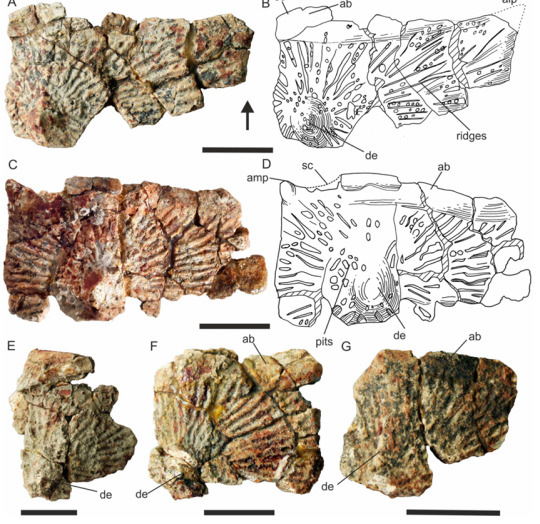
I'll be entirely honest. This was a lot more work to type out than anticipated, but admittedly also fairly rewarding. Hopefully you dear reader found it equally interesting, and hey, congrats on making it to the end.
#palaeoblr#paleontology#prehistory#croc#crocodile#long post#pseudosuchia#sutekhsuchus#argochampsa#peirosauridae#thalattosuchia#metriorhynchoidea#teleosauroidea#kuttysuchus#aetosauria#paralligator#leidyosuchus#cryodrakon#borealosuchus
142 notes
·
View notes
Text
Recently my friend found a dinosaur named after Odysseus, and I got obsessed. It's name is Ajnabia odysseus (Anjanabia meaning "traveller" or I found it also as meaning the stranger or foreigner)
Ajnabia odysseus comes from the late Cretaceous, the fossils were found in Morocco, North Africa. It was a duck-billed dinosaur belonging to Hadrosauridae, common herbivore dinosaurs. (I absolutely adore that dinosaur named after Odysseus is a duck billed dinosaur as Penelope's name means "Weaver; Duck" and this little dino was definitely not named this because of that, but it is an adorable coincidence.)
Hadrosauridaes could be quite large, but not Ajnabia odysseus who were only about 3 meters long, making them very small compared to the other Hadrosauridaes. Before Ajnabia odysseus, hadrosaur species had only been found throughout North America, Europe and Asia. Making their discovery a surprise and sparking theories of just how much more widespread and adaptable they were. Theories were that the hadrosaurs evolved in North America, before spreading into Asia and Europe.
And why this little guy is so special is because of where they were found specifically. During the time they were alive, there was no way to walk there. At least so far there is no evidence of any land bridges. Which means this dinosaur had to swim there. Which would be incredibly interesting as he whole Africa was an island continent, surrounded by deep water which had to have many predatory species.
So, so far the leading and the most plausible theory on how this little traveller got to where paleontologists found them, is that they managed to swim through vast seas, even parts of ocean, to get where the fossils were found today.
And I found this dinosaur personally absolutely adorable and it has to be one of my favourites now. (And I had to draw one with Odysseus)

29 notes
·
View notes
Text
Sturgeon
Sturgeon (from Old English styrġa ultimately from Proto-Indo-European is the common name for the 28 species of fish belonging to the family Acipenseridae. The earliest sturgeon fossils date to the Late Cretaceous, and are descended from other, earlier acipenseriform fish, which date back to the Early Jurassic period, some 174 to 201 million years ago. They are one of two living families of the Acipenseriformes alongside paddlefish (Polyodontidae). The family is grouped into four genera: Acipenser (which is paraphyletic, containing many distantly related sturgeon species), Huso, Scaphirhynchus, and Pseudoscaphirhynchus. Two species (A. naccarii and A. dabryanus) may be extinct in the wild, and one (P. fedtschenkoi) may be entirely extinct. Sturgeons are native to subtropical, temperate and sub-Arctic rivers, lakes and coastlines of Eurasia and North America. A Maastrichtian-age fossil found in Morocco shows that they also once lived in Africa.
Sturgeons are long-lived, late-maturing fishes with distinctive characteristics, such as a heterocercal caudal fin similar to those of sharks, and an elongated, spindle-like body that is smooth-skinned, scaleless, and armored with five lateral rows of bony plates called scutes. Several species can grow quite large, typically ranging 2–3.5 m (7–12 ft) in length. The largest sturgeon on record was a beluga female captured in the Volga Delta in 1827, measuring 7.2 m (23 ft 7 in) long and weighing 1,571 kg (3,463 lb). Most sturgeons are anadromous bottom-feeders, migrating upstream to spawn but spending most of their lives feeding in river deltas and estuaries. Some species inhabit freshwater environments exclusively, while others primarily inhabit marine environments near coastal areas, and are known to venture into open ocean.

63 notes
·
View notes
Text
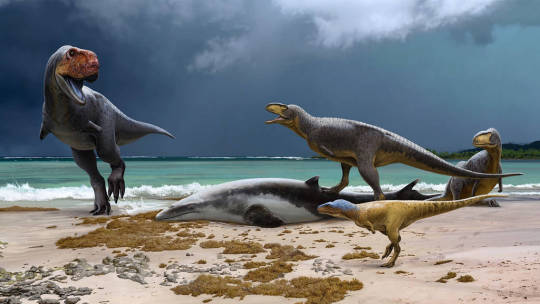
[ Artistic reconstruction of three abelisaurids recently discovered in Morocco, illustrated by Andrey Atuchin. ]
"Fossils of two newly discovered carnivorous dinosaurs have been found in Morocco. The animals lived at the end of the Cretaceous period just before the mass extinction event 66 million years ago, and show dinosaurs were diverse in Africa before going extinct. Both predators belong to a primitive family known as abelisaurids. These dinosaurs were bipedal theropods with very short, vestigial arms (even shorter than Tyrannosaurus rex) and short bulldog-like snouts. Among the most famous abelisaurids is the two-horned Carnotaurus which would have been about 8 metres in length. While North America and east Asia were dominated by tyrannosaurine giant predators like T. rex and Tarbosaurus, abelisaurids were widespread across Africa, south Asia, Madagascar and South America. One of the new Moroccan abelisaurids was found in Sidi Chennane, just outside Casablanca. It is known from a fossilised shin bone which suggests a medium-sized carnivore about 5 metres long. The other was found at Sidi Daoui, also near Casablanca, but would have been much smaller at about 2.6 metres in length. Both are described in a paper published in the journal Cretaceous Research."
Read more: "T. rex cousins discovered in Morocco shed light on last dinosaurs in Africa" by Evrim Yazgin.
#palaeoblr#Palaeontology#Paleontology#Dinosaurs#Theropods#Morocco#Article#Prehistoric#Mesozoic#Cretaceous#Extinct#Art
210 notes
·
View notes
Text
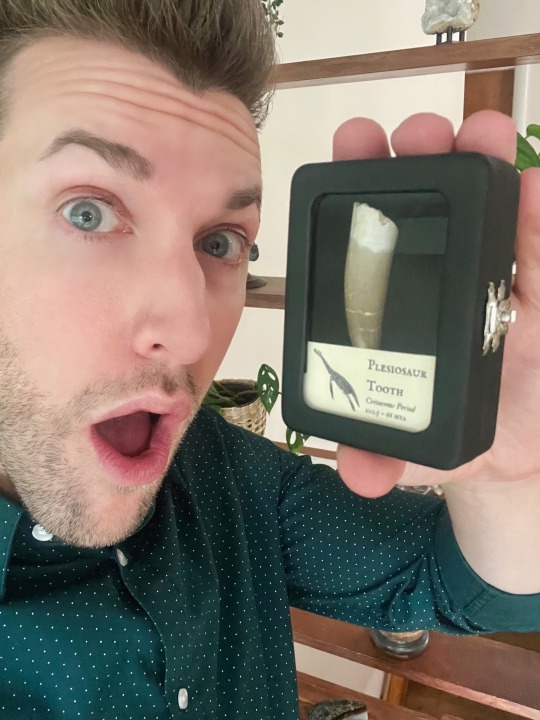

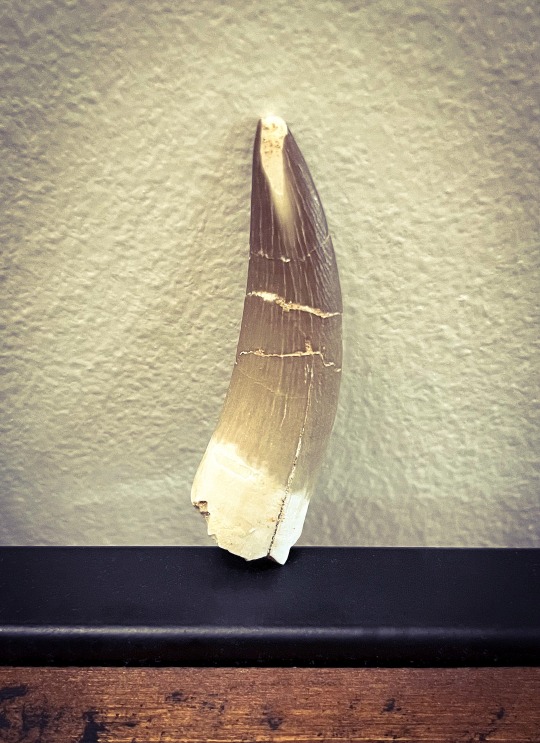
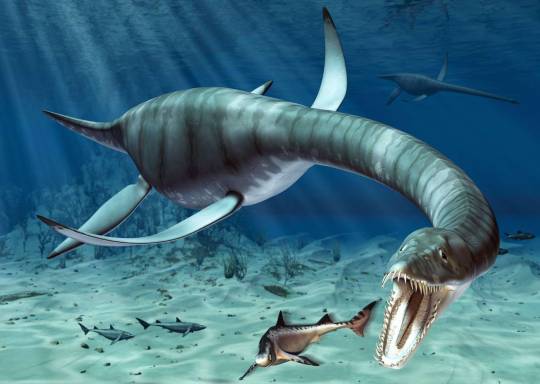
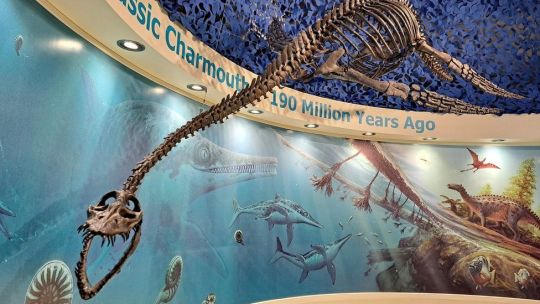

Just added another super cool fossil to the collection! This genuine Plesiosaur tooth was found in Morocco and dates all the way back to the Cretaceous period. It’s also quite a large specimen, measuring almost 2.5” in length!
Plesiosaurs are often mistaken for dinosaurs, however these prehistoric creatures are actually part of a separate group known as "marine reptiles." They first evolved in the Triassic (208.5 MYA) and thrived until the massive KT extinction event caused by the Chicxulub asteroid. This took place at the end of the Cretaceous, and was the same extinction event that wiped out the non-avian dinosaurs (66 MYA). 💥🌊
#collecting#collection#collectibles#collector#dinosaurs#dinosaur#dino#dinos#plesiosaur#loch ness monster#nessie#marine reptile#tooth#fossil#fossils#prehistoric#when dinosaurs ruled the earth#paleontology
90 notes
·
View notes
Text
Fish of the Day
Today's fish of the day is the Freshwater Plesiosaur!
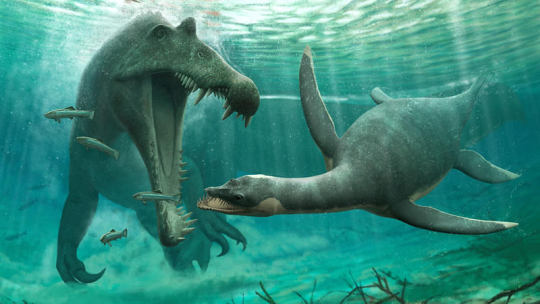
The freshwater plesiosaur was requested by Jasper, thank you Jasper! Plesiosaurus as a marine reptile, well known for their prowess as apex predators, but freshwater plesiosaurs are a relatively new idea. Based on the finding of a couple of fossils in what is now Morocco's Sahra desert river system, specifically an area called the Kem Kem beds. These fossils are scattered, showing us that this is not just the bones of one animal but a group of freshwater plesiosaurs that lived in the area, at least a dozen of them. The finding of many teeth in particular shows that these animals didn't just swim in from the ocean temporarily, but lived in the area long enough to shed teeth. This has led to some theories that the popular cryptid, The Loch Ness Monster, may be a freshwater plesiosaur, although no fossils have been yet found in that area. Although this does not confirm their existence it raises a strong argument for them. However, with limited knowledge about them for the time being, let's go over plesiosaurs in general!
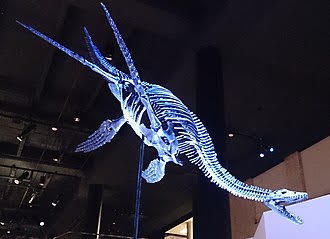
Found and named in the early 1800's the plesiosaur, from order Plesiosauria, is thought to have first appeared in the late Triassic Rhaetian stage, about 203 million years ago. These animals went extinct about 66 million years ago, to the Cretaceous-Paleocene extinction event. How they swam is still up for debate, many favor the theory that they had wide range with each of their fins, and had identical strokes, but other theories are that they may have used only the fore or hind fins for locomotion, or perhaps used them in reciprocal movement. Similar debate exists for how these animal may have dived, although we know they dived for food, as signs of decompression sickness have been found. As apex predators they ate through anything they could get close to, small fish, larger fish, sharks, cetaceans, crustaceans, one another. It is found that although they were certainly near the top of the food chain, some of them were still occasionally prey for large sharks, but mostly they fell to one another, larger plesiosauria hunting smaller. It is thought they evolved to fill the niche left open by the extinction of Ichthyosaurs, which died out in the late Cretaceous, and allowed for diversification to take place in Plesiosauria. Plesiosauria during this era evolved two distinct morphological types: the pliosauromorph build, the Pliosauroidea family, and the plesiosauromorph build, the Plesiosauroidea family.
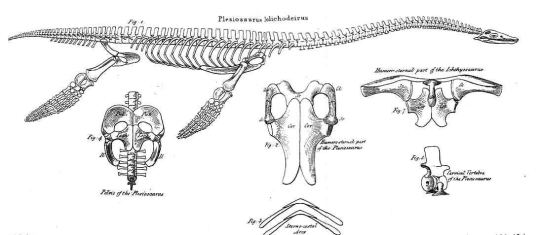
Pliosauroidea is defined by their large heads and short necks, often compared to the build that crocodiles have. They are also known for having larger hind flippers than other plesiosaurs and can be found mostly across South America, and along the equator, although some fossils have been found as far north as Norway. The largest genus found so far, the Liopleurodon, is as large as 6 feet 5 inches, or just a little under 2 meters.

Plesiosauroidea was defined by the long skinny neck, which was used to hunt in small holes, and could move fast to snap up small marine animals nearby them. Although Plesiosauroidae is often depicted as a fast moving predator, it is found that they were likely slow swimmers, pushing their way through the water similar to the swimming methods of turtles, staying close to the surface and using their four limbs for mobility, making it easy to snap at nearby animals. Despite the common displays of them in swan-like positions, with the head raising out of the water, this is unrealistic, as they could not raise their heads up to a degree like that, and the weight of the muscles would prevent them from surfacing. The size difference between differing species was huge, as some could be only as large as 3 meters to 20 meters in length. It is currently thought that the freshwater finds belong to Plesiosauridea.
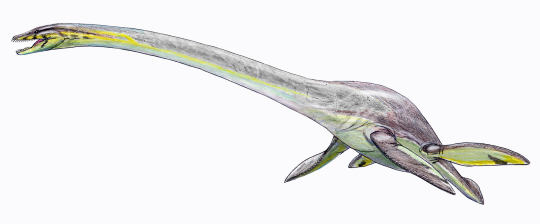
Everyone have a good day!
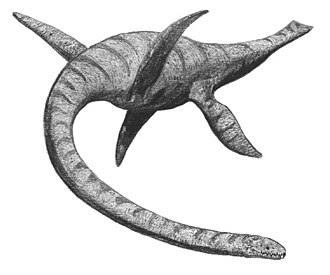
#fish#fishblr#fishes#fishposting#aquatic biology#aquatic#marine biology#ichthyology#marine animals#marine life#freshwater#freshwater fish#animal#animals#animal facts#fish of the day#information#education#nature#river#paleo#paleontology#plesiosaur#plesiosaurus#freshwater plesiosaur#Plesiosauria#Pliosauroidea#Plesiosauroidea
29 notes
·
View notes
Text
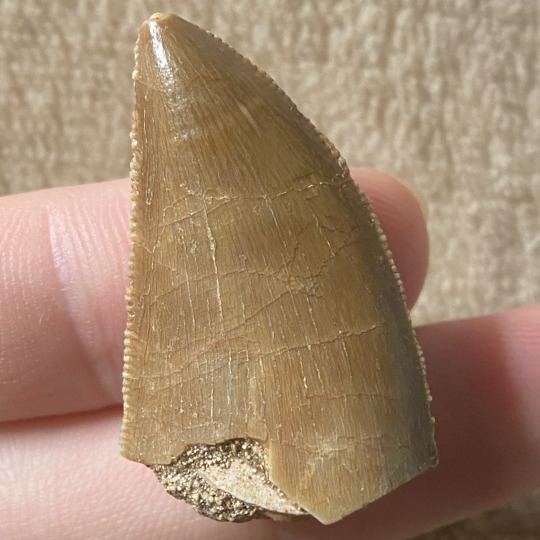
A dinosaur tooth of a Chenanisaurus barbaricus from the Couche III in the phosphate mines of Oued Zem, Khouribga, Morocco. This rare abelisaurid theropod lived at the very end of the Cretaceous during the Maastrichtian. Fossils like Chenanisaurus are unusual as these are terrestrial species found in marine deposits, and represent rare dinosaur remains washed out to sea.
#dinosaur#fossils#paleontology#palaeontology#paleo#palaeo#chenanisaurus#abelisauridae#theropod#cretaceous#mesozoic#prehistoric#science#paleoblr#チェナニサウルス#アベリサウルス科#恐竜#化石#古生物学
32 notes
·
View notes
Text
file : interesting creatures (#1): spinosaurus !
info requested by anon! rhykar copypasted the ENTIRE spinosaurus fun facts post in our drafts onto this post; therefore, thank us both for this one!
the spinosaurus aegyptiacus was a spinosaurid dinosaur that lived in what is now north africa, its reign taking place in the mid and late cretaceous period around 93.5 to 110 million years ago, in the cenomanian and albain ages. it went extinct near the end f the cretaceous period.
the spinosaurus aegyptiacus' habitat consisted mostly of mangrove forests and tidal flats (muddy, marshy areas of mostly flat land that tend to be covered in sea or delta water). most of the area it lived in included the land that now harbors egypt and morocco.
spinosaurus fossils have been found in egypt, morocco, tunisia, libya, kenya and algeria, in the bahariya formation (egypt)*, aoufous and tegana formations [kem kem beds] (morocco), chenini formation (tunisia), cabao formation (libya), turkana grits formation (kenya), and gara samani, algeria, as well as the ain el guettar formation, also in tunisia. (fossils of similar spinosaurid have been found in thailand, southern england, brazil, niger, laos, and the isle of wight, among others. pelvic bones and vertebrae found to belong to the spinosaurus aegyptiacus have also been found on the isle of wight.)
the first spinosaurus aegyptiacus fossils were found in the bahariya oasis, in the western egypt desert! these fossils were discovered in 1912, and the spinosaurus was named by paleontologist ernst stromer. the original remains were destroyed in world war 2, on april 24th, 1944.
"spinosaurus" translates from latin. it literally just means "spined lizard."
as is generally obvious knowledge, jurassic park was ridiculously inaccurate. there's a lot, but here's a few!
1: the spinosaurus in the movie had inaccurate jaw strength; a real spinosaurus, who would probably have never even encountered a tyrannosaurus rex, would never have had to adapt to develop a bite force strong enough to break a nearly fully-grown tyrannosaur's neck. (probably not any tyrannosaur- not just the rex.)
2: the nasal horn on the spinosaurus in the movie was unrealistically sharp; paleontology has generally shown that it was probably more blunt.
3: the lacrimal ridges on the spinosaurus in the movie were too small for a spinosaurus the age of the one in the movie. a scientific accuracy would have shown a spinosaurus with a much bigger and more developed set of lacrimal ridges.
4: it is trivial knowledge that the spinosaurus aegyptiacus was bigger than the tyrannosaurus rex; the one in the movie was barely a handful of inches taller than the tyrannosaurus rex it killed; that tyrannosaurus rex was also a juvenile.
we used to nearly collectively think that the spinosaurus hunted in deep rivers and on ocean shores, but recent studies have shown substantial evidence that the spinosaurus was more like a gigantic, evil, probably very smart reptilian heron from hell.
spinosaurus most likely spent more time on the river shores of their north african habitats than inland. evidence of this conclusion includes: a) its nostrils are positioned toward the middle of its snout, suggesting it could mostly submerge itself in order to hide from territorial rivals. b) its pelvis was smaller than most other large carniverous theropods, which suggests that it used the things attached to said pelvis, the tail and hind legs, to chase after quick-moving small riverside creatures and assist itself in submerging into rivers when it had to hide. c) the vertebrae of its tail was also oddly loosely connected, which suggests it used it as a sort of balance to swim or run after riverside prey rather than using it as an aid in deep-sea plunder.
recently discovered evidence suggests that the spinosaurus may have been covered in a skin membrane that could change color, which would have assisted in temperature regulation in cold rivers and potentially have aided in attracting mates and intimidating other dinosaurs. the membrane may have also enabled the spinosaurus to act something like the indominus rex, changing its color to camoflauge itself with its surroundings to hunt, or to hide if a water source was not available or safe to hide in.
we used to think the spinosaurus's sail was used solely for swimming and temperature regulation. but recent discoveries seem to suggest otherwise- the sail may have been used for social displays or species recognition. some also believe the sail was used to store water and lipids in case a river any individual spinosaurus lived near began to dry up.
*1: the particular location mentioned, in more specifics, would be the bahariya oasis in the western desert of egypt.
sources : the dominating source i'd like to give credit to for the information in this post is rhykar, my lovely nerdy professional ghost hunting boyfriend, fellow owner and creator and primary organization person of this account!
send an ask if you want more info, or if you've got more to share! please use this post as a source if you post or use information you found on it!
#+ file : creatures#+ subfile : dinosaurs - spinosaurus#+ researcher : hayle#dinosaurs#spino#spinosaurus#spinosaurus aegyptiacus#fun facts#jurassic park#jurassic park inaccuracies#africa#african dinosaurs#prehistory#prehistoric creatures#spinosaurus facts#dinosaur facts
3 notes
·
View notes
Text
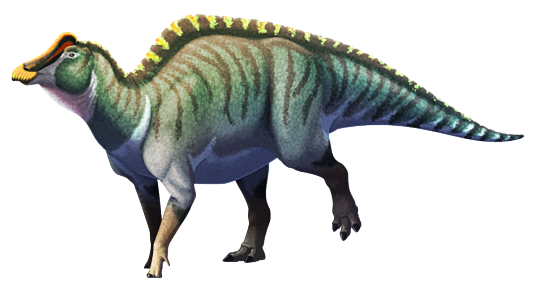
For a long time there were no hadrosaurid fossils known from Africa.
This seemed to mainly be due to the limits of the geography of their time. Hadrosaurs evolved and flourished during the late Cretaceous, when Africa was isolated from all the other continents, and they didn't seem to have ever found their way across the oceanic barriers.
…Until in 2021 a small hadrosaur was discovered in Morocco, a close relative of several European species, showing that some of these dinosaurs did reach northwest Africa just before the end of the Cretaceous - and with no land bridges or nearby island chains to hop along, they must have arrived from Europe via swimming, floating, or rafting directly across several hundred kilometers of deep water.
And now another hadrosaur has just been described from the same time and place.
Minqaria bata lived in Morocco at the very end of the Cretaceous, about 67 million years ago. Only known from a partial skull, its full appearance and body size is unknown, but it probably measured around 3.5m long (~11'6") – slightly larger than its previously discovered relative, but still very small for a hadrosaur. It might represent a case of insular dwarfism, since at the time Morocco may have been an island isolated from the rest of northwest Africa.
Along with its close relative Ajnabia, and at least one other currently-unnamed larger hadrosaur species, Minqaria seems to be part of a rapid diversification of hadrosaurs following their arrival in Morocco, adapting into new ecological niches in their new habitat where the only other herbivorous dinosaur competition was titanosaurian sauropods, and the only large predators were abelisaurs.
If the K-Pg mass extinction hadn't happened just a million years later, who knows what sort of weird African hadrosaurs we could have ended up with?
———
NixIllustration.com | Tumblr | Patreon
#science illustration#paleontology#paleoart#palaeoblr#minqaria#hadrosaur#hadrosauridae#ornithopod#ornithischia#dinosaur#art#insular dwarfism#african hadrosaurs!
453 notes
·
View notes
Text

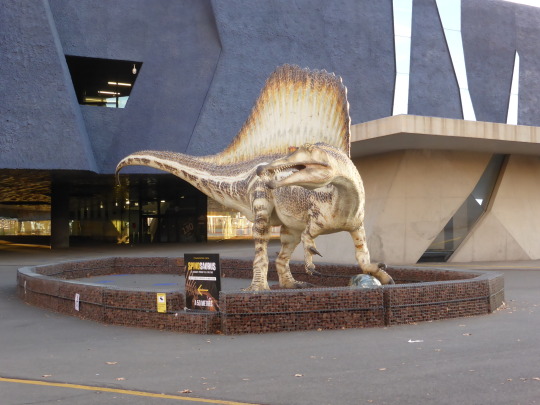

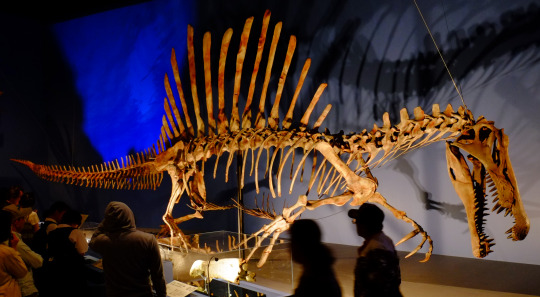
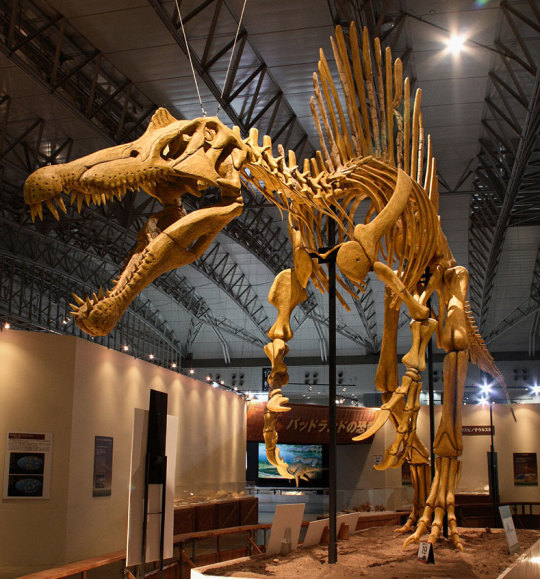
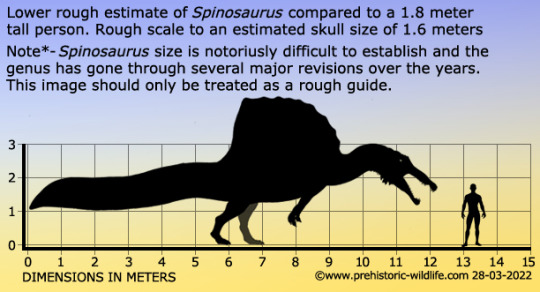
Spinosaurus
(temporal range: 99-93.5 mio. years ago)
[text from the Wikipedia article, see also link above]
Spinosaurus (/ˌspaɪnəˈsɔːrəs/; lit. 'spine lizard') is a genus of spinosaurid dinosaur that lived in what now is North Africa during the Cenomanian to upper Turonian stages of the Late Cretaceous period, about 99 to 93.5 million years ago.[2][3] The genus was known first from Egyptian remains discovered in 1912 and described by German palaeontologist Ernst Stromer in 1915. The original remains were destroyed in World War II, but additional material came to light in the early 21st century. It is unclear whether one or two species are represented in the fossils reported in the scientific literature. The best known species is S. aegyptiacus from Egypt, although a potential second species, S. maroccanus, has been recovered from Morocco. The contemporary spinosaurid genus Sigilmassasaurus has also been synonymized by some authors with S. aegyptiacus, though other researchers propose it to be a distinct taxon. Another possible junior synonym is Oxalaia from the Alcântara Formation in Brazil.
Spinosaurus is the longest known terrestrial carnivore; other large carnivores comparable to Spinosaurus include theropods such as Tyrannosaurus, Giganotosaurus and Carcharodontosaurus. The most recent study suggests that previous body size estimates are overestimated, and that S. aegyptiacus reached 14 metres (46 ft) in length and 7.4 metric tons (8.2 short tons) in body mass.[4] The skull of Spinosaurus was long, low, and narrow, similar to that of a modern crocodilian, and bore straight conical teeth with no serrations. It would have had large, robust forelimbs bearing three-fingered hands, with an enlarged claw on the first digit. The distinctive neural spines of Spinosaurus, which were long extensions of the vertebrae (or backbones), grew to at least 1.65 meters (5.4 ft) long and were likely to have had skin connecting them, forming a sail-like structure, although some authors have suggested that the spines were covered in fat and formed a hump.[5] The hip bones of Spinosaurus were reduced, and the legs were very short in proportion to the body. Its long and narrow tail was deepened by tall, thin neural spines and elongated chevrons, forming a flexible fin or paddle-like structure.
Spinosaurus is known to have eaten fish, and most scientists believe that it hunted both terrestrial and aquatic prey. Evidence suggests that it was semiaquatic; how capable it was of swimming has been strongly contested. Spinosaurus's leg bones had osteosclerosis (high bone density), allowing for better buoyancy control. Multiple functions have been put forward for the dorsal sail, including thermoregulation and display; either to intimidate rivals or attract mates. It lived in a humid environment of tidal flats and mangrove forests alongside many other dinosaurs, as well as fish, crocodylomorphs, lizards, turtles, pterosaurs, and plesiosaurs.
9 notes
·
View notes
Text
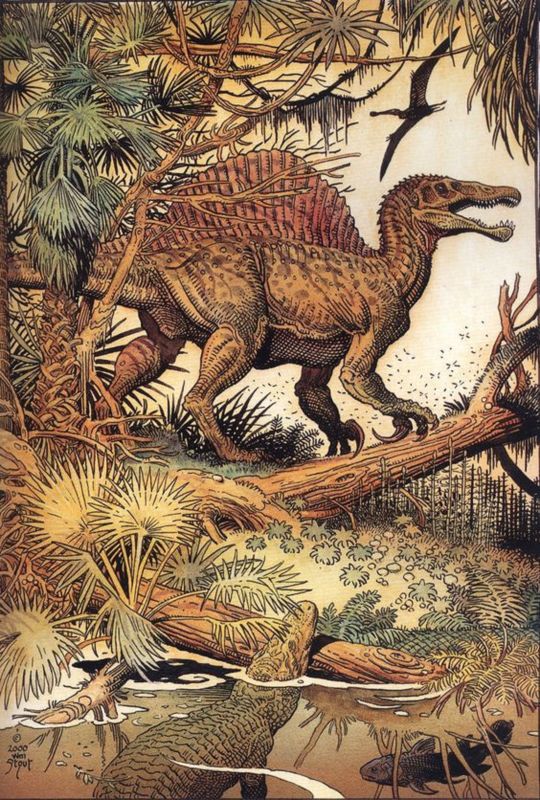
SPY-noh-SOAR-uss -- THE "SPINY LIZARD" OF PRESENT DAY NORTH AFRICA.
PIC INFO: Resolution at 1692x2508 -- Spotlight on Spinosaurus (meaning "spine lizard"), a genus of theropod dinosaur that lived in what now is North Africa during the upper Albian to upper Turonian stages of the Cretaceous period, about 112 to 93.5 million years ago.
The best known species is S. aegyptiacus from Egypt, although a potential second species, S. maroccanus, has been recovered from Morocco. Artwork by William Stout, c. 2000.
Name: Spinosaurus (Spine lizard)
Phonetic: Spine-oh-sore-us.
Named By: Ernst Stromer - 1915.
Synonyms: Sigilmassasaurus?
Classification: Chordata, Reptilia, Dinosauria, Saurischia, Theropoda, Megalosauroidea, Spinosauridae, Spinosaurinae.
Species: S. aegyptiacus (type), S. maroccanus is a possible second, although many consider this species as being the same as the type species.
Diet: Piscivore/Carnivore.
Size: Estimates highly variable amongst sources and range anywhere between 12.6 and 18 meters total body length. Skull length estimated between 1.5 and 1.75 meters long.
Known locations: North Africa, particularly Egypt - Bahariya Formation, and Morocco - Kem Kem Beds.
Time period: Albian to Cenomanian of the Cretaceous.
Fossil representation: To date at least six partial specimens of the skull, mandible, neural spines and other fragmentary post cranial remains. Teeth however are considerably more common.
Sources: www.prehistoric-wildlife.com/species/s/spinosaurus.html, www.mindat.org/taxon-4967112.html, & Pinterest.
#Spinosaurus#William Stout#Dino Art#Spinosaurus Aegyptiacus#S. aegyptiacus#Theropod#Dinosaurs#Late Cretaceous#William Stout Art#Paleoart#Dinosaur Art#Spinosaurus aegypticus#Spinosauridae#Prehistoric#Prehistory#Prehistoric Creatures#Prehistoric Animals#William Stout Artist#Palaeoart#Palaeo Art#Dinosaur#Illustration
6 notes
·
View notes
Text

Globidens Mososaur Tooth
The fossilised tooth of a Mososaur of the Globidens genus.
Mososaur from this genus had large, rounded teeth that were comparatively shorter than other types of Mososaur.
Globidens Mososaurs teeth were specialised for dealing with armoured prey, allowing them to crust the tough shells of prey such as turtles, ammonites, nautili and bivalves.
Globidens Mososaurs were of a relatively medium size as far as Mososaur go reaching around 5-6 metres in length.
They existed during the late Cretaceous period approximately 84.9 to 66 million years ago.
This tooth here was recovered from Morocco though fossils of this species have also been found in Angola, Brazil, Columbia, Syria and the USA.
1 note
·
View note
Text
Scientists suspect a newly discovered mosasaur fossil is a fake.
In 2021, scientists identified a new species of mosasaur after discovering a Cretaceous jaw with unusual teeth in a mine in Morocco. There was just one problem—the remains might have been forged. Researchers in Canada have questioned the accuracy of fossils used to identify and describe a new species of extinct marine reptile. Xenodens KalminechariIn 2021, their analysis Details will be available…
0 notes